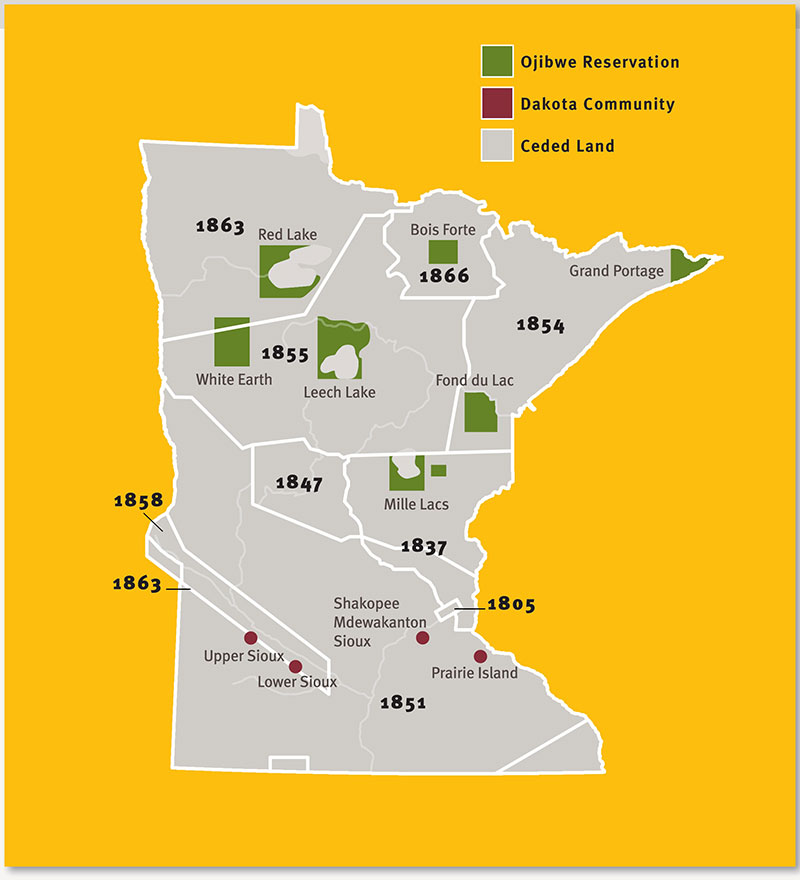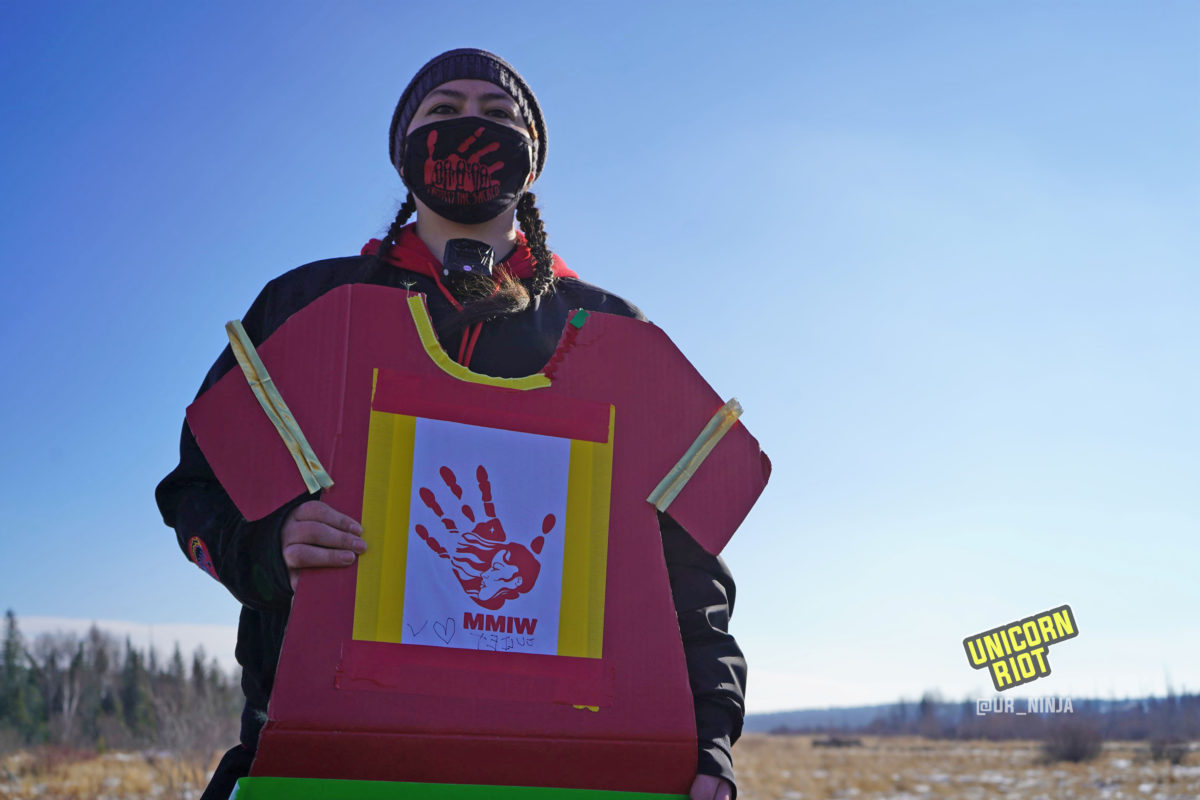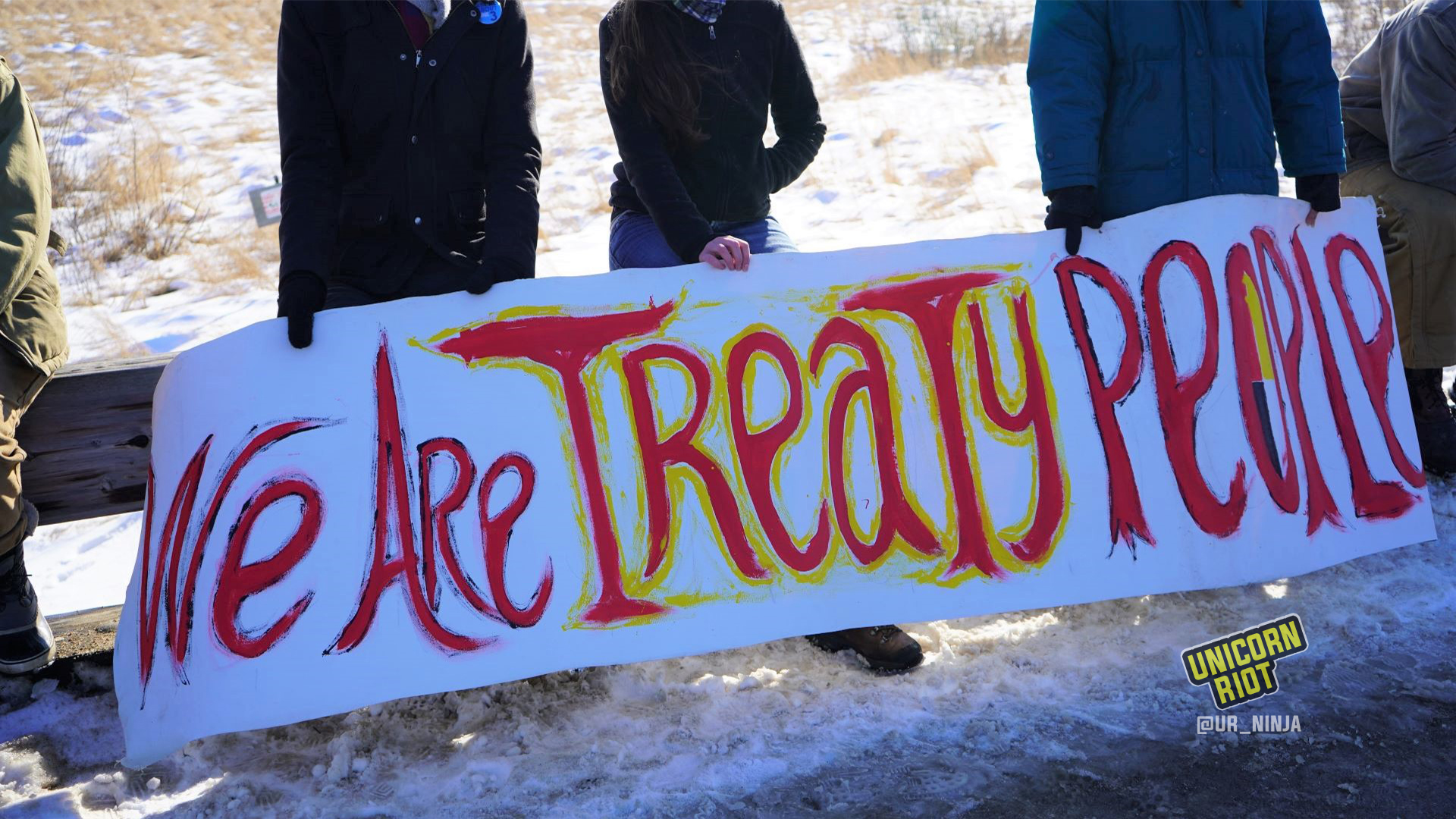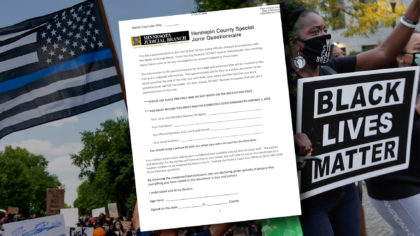Treaty Rights Asserted During Creation of White Earth Camp
White Earth Reservation, MN – On February 20, 2021, the White Earth Camp opened up as an additional Indigenous Women/Femme-led water protector community. On Sunday, February 21, the camp hosted a treaty rights action at a work site where oil giant Enbridge plans to bore under the Mississippi River and lay the new Line 3 tar sands pipeline under it.
Around 50 people held space on the bridge overpass on top of the frozen river. Prayers, songs and chants were shared while soaking up the warm sun. Two Carlton County Sheriff’s deputies arrived at the scene, but kept their distance.
In the video above, we interviewed Everlasting Wind, one of the founders of the White Earth Camp. She told us how she is angry “because the treaties have been ignored so long that people think it’s OK and irrelevant, but it’s not.”
This [1855] treaty was made with the agreement of letting the settlers come and settle the lands and prosper, and the Anishinaabe agreed to live in peace. So it’s often misunderstood that we were given rights, we actually retained our rights and gave the rights to the settlers to come and settle land.
Everlasting Wind
At the start of the rally, Nancy, a co-founder of White Earth Camp, spoke directly to the white allies at the rally:
We signed those treaties with your forefathers to protect our culture; our way of life. We have never, ever, surrendered our right to protect our water, and we’re not about to give it up.”
Nancy
From 1837 to 1867 about 10 treaties were signed between the Ojibwe and Dakota people and the U.S. government where millions of acres were ceded. In the 1837 treaty, the Ojibwe (Chippewa) Nations ceded land from what is now north-central Wisconsin to east-central Minnesota; however as Article 5 of the treaty states, not everything was given up:
“The privilege of hunting, fishing, and gathering the wild rice, upon the lands, the rivers and the lakes included in the territory ceded, is guaranteed to the Indians, during the pleasure of the President of the United States.”
— Article 5 of the 1837 Land Cession Treaty
During the late 1900s, Indigenous people faced harassment and arrest when asserting their treaty rights in ceded territory in Michigan, Minnesota, and Wisconsin. After many legal battles, a final ruling was made by the U.S. Supreme Court in 1999 known as Minnesota v. Mille Lacs Band of Chippewa Indians, which affirmed the rights of the Ojibwe to hunt, fish, and gather on the lands ceded by treaty.

While it’s true that “treaties have been ignored for so long,” there are also treaties, or sections of treaties, which the U.S. government upholds, or pushed for in the first place, because the settlers and government benefit greatly.
In the 1837 treaty, owners of the American Fur Company used their political connections to guarantee that when Dakota and Ojibwe people received compensation for ceded land—which amounted to $16,000 in cash and goods up front—the fur traders were set to receive over five times that amount.
Kevin Gover (Pawnee) is the director of the National Museum of the American Indian, and from his perspective, the beginning of U.S.-Native treaty making was promising because it seemingly included “American acceptance of tribal self-government and nation-to-nation diplomacy.”
“That promising start quickly morphed into disaster through broken and coercive treaties that promoted Indian removal and tribal land loss, as well as government policies that dismantled tribes as political institutions, obliterated tribal land ownership and fostered the forced assimilation of Native people into white culture.”
Kevin Gover (Pawnee)

When we asked what Everlasting Wind hopes will come from the White Earth Camp, she said, “that our people begin to heal.”
“We have so much generational trauma that’s carried; we carry that. And to this day we are still being traumatized. This is traumatizing. People don’t understand that; they don’t understand the magnitude of this.
Like I said ‘site specific,’ yes [the pipeline] endangers this area, and it endangers the waters and the wetlands and our wild rice, but it’s at a higher level of climate change. And so with climate change, that puts our natural elements—our four elements—out of balance; we are out of balance.
And that is what climate change is, it’s our environment out of balance. So, that puts our Anishinaabe lifeways at risk.”
Everlasting Wind
Follow us on X (aka Twitter), Facebook, YouTube, Vimeo, Instagram, Mastodon, Threads, BlueSky and Patreon.
Unicorn Riot's Line 3 Oil Pipeline Coverage:
- Landing Page for all Unicorn Riot Line 3 Resistance Coverage
- Minnesota Attorney General Keith Ellison Speech Disrupted by Water Protectors - October 8, 2021
- Over 50 Line 3 Pipeline Protesters Arrested Outside MN Governor’s Residence - September 22, 2021
- Police Break Up Ceremony and Indigenous-Led #StopLine3 Occupation - August 31, 2021
- Hundreds March from Governor Residence, Urge Chase Bank Defund Line 3 - August 31, 2021
- First Trial from Treaty People Gathering Ends in Acquittal - August 23, 2021
- Line 3 Opponent Sentenced to Thirty Days in Jail - August 19, 2021
- Enbridge Spills 10,000 Gallons of Line 3 Drilling Fluid - August 16, 2021
- Line 3 Fusion Center Data Declared Secret - August 4, 2021
- Judge Orders Sheriff to Halt Harassment of Line 3 Resistance Camp - July 24, 2021
- Water Protectors Occupy Work Sites and Lock Down to Line 3 Pipeline Construction - July 1, 2021
- Hubbard County Barricades Private Property, Imprisons Water Protectors - June 28, 2021
- Indigenous-Led Blockades Occupy Line 3 Pipeline Sites - June 10, 2021
- Rising Up to the Heat: ‘Treaty People Gathering’ Resists Line 3 Pipeline - June 7, 2021
- Activists Serve Denver Wells Fargo Eviction Notice - May 3, 2021
- Appealing Line 3 Pipeline: Supply and Demand at Root of Hearing - March 23, 2021
- Caravan Disrupts Line 3 Construction Routes, Carlton County Triggers Backlash - March 13, 2021
- Treaty Rights Asserted During Creation of White Earth Camp - March 13, 2021
- 70 Water Protectors Cited, 1 Arrested During Line 3 Commemorative Rally - March 4, 2021
- Bipod and Car Blockade Jam Up Line 3 Construction - March 2, 2021
- Three Lock Down Inside Line 3 Pipeline For 6+ Hours - Feb. 21, 2021
- Lockdown to Keep it in the Ground: Line 3 Resistance - Feb. 15, 2021
- Court of Appeals Denies Motion to Stop Line 3 - Feb. 3, 2021
- Opposition to Line 3 Mounts - Jan. 29, 2021
- Resistance to Line 3: Direct Actions Aim to Stop Construction - Jan. 11, 2021
- Enbridge Line 3 Construction Blocked by Activists in Northern Minnesota - Nov. 18, 2020
- Protests After Permits for Line 3 Oil Pipeline Approved - Nov. 17, 2020
- ‘No KKKops, No Pipelines’ Banner Dropped in Minneapolis - Oct. 6, 2020
- “Divest from Climate Change!” Chase Bank Branch Protested on Opening Day - Nov. 7, 2019
- March to Protect The Sacred on Indigenous People’s Day 2019 - Oct. 14, 2019
- Hundreds Rally in Opposition to Line 3 Tar Sands Pipeline in Minnesota - Sept. 28, 2019
- Direct Action in Minnesota as Line 3 Pipeline Approval Reversed - June 3, 2019
- Multi-Agency Task Force Prepares “Rules of Engagement” For Line 3 Protests - Feb. 11, 2019
- ‘Valve Turners’ Shut Down Enbridge Oil Pipelines in Minnesota - Feb. 4, 2019
- Arts, Culture, and Hip Hop Resist Line 3 as Lawsuits Against Approval Continue - Dec. 29, 2018
- Minnesota Police Train at Military Base as Line 3 Pipeline Protests Escalate - Oct. 25, 2018
- Judge Accepts Water Protectors’ Climate Change Necessity Defense - July 18, 2018
- Line 3 Oil Pipeline Approved By Minnesota Regulators - June 28, 2018
- As Line 3 Oil Pipeline Decision Looms, Indigenous Resistance Increases - June 26, 2018
- Interfaith Community Delivers Letter of Line 3 Opposition to Minnesota Government Offices - June 4, 2018
- Minnesota Public Utilities Commission Requests Line 3 Schedule Change - Jan. 10, 2018
- Rally Against Line 3 Minnesota Pipe Yards - Dec. 11, 2017
- Resistance to Line 3 Pipeline Seeks to Save Sacred Manoomin - Oct. 9, 2017
- Direct Action Ramps Up Resistance to Line 3 - Sept. 18, 2017


